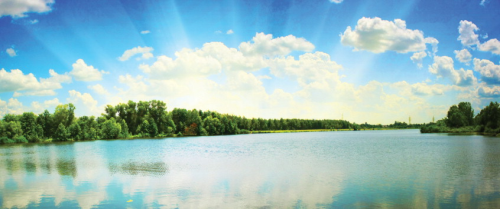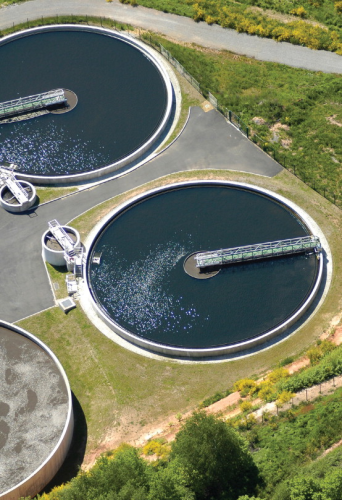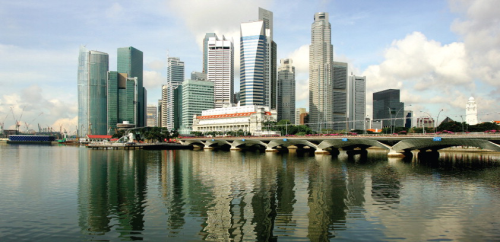


In this article we investigate the forces driving wastewater reuse, the now proven technology available and the role international legislation has to play in regard to the implementation of wastewater reuse projects. Across Europe and the majority of the developing countries water audits are now formally reported to regulators. This means that technological solutions for reusing wastewater are more common, particularly in water-intensive industries (for example food and drink). Coupled with increased treatment costs at wastewater treatment works derived from enhanced treatment requirements, extra energy required by more treatment stages, and resultant pressure on water volume acceptance costs, it is likely that on-site wastewater reuse will become increasingly more commonplace. We outline the approach to implementing best available techniques (BATs) as applied to industry in general, present a large scale example of a proven wastewater reuse project and include details on how to find out more about integrated pollution prevention and control (IPPC) legislation in Europe and the United States.
Legislation and market forces
The major impetus for reusing wastewater over recent years has come from the increasing pressure on natural water resources, as evidenced by the effects of global climate change and shifting weather patterns. Wastewater reuse can help conserve the supply of freshwater, and this presents clear advantages with respect to environmental protection. In countries where industrial wastewater reuse is important, it is not only because of the lack of water but also because of government enforcement through legislation. In mainly developing countries, water reuse is practiced for other purposes, mainly agriculture, while industry focuses more on reducing water consumption.
In addition to government intervention, wastewater reuse also tends to arise due to market forces – from the potential savings in related supply and discharge costs that can be realised.
In the book Membranes for Industrial Wastewater Recovery and Reuse (Judd, S J & Jefferson, B (2003, Elsevier Science Publishers Ltd, UK), Judd & Jefferson reported that between 1980 and 1995 water supply and discharge costs trebled in the UK and increased by more than an order of magnitude in California, US. This increase in the UK was primarily due to the privatisation of the water industry and the significant investment that arose from the separation of treatment and policing functions (both previously carried out by the replaced water authorities). The founding of the National Rivers' Authority (now part of the UK's Environmental Protection Agency, EPA) resulted in significant improvements in river water quality coupled with increases in water supply and discharge costs to pay for the improvements. Cost increases have leveled off slightly over the last decade but continue to escalate at a rate well above inflation.
The economic motivation for reuse of industrial wastewater can be a major driving force as many industries consume large volumes of water. In all these industries water is a valuable resource, and in many cases this resource can be recovered by the reuse of wastewater, especially where the quality of the supplied freshwater, predominantly of potable standard, either exceeds that demanded by the industrial process or else demands further processing.
In the European Community, IPPC Directive 96/61/EC (1996) governs how industries must prevent and control emissions of pollutants to the environment. Central to the legislation are BATs. In Article 2(11) of the directive, a BAT is defined as
“the most effective and advanced stage in the development of activities, and their methods of operation, which indicate the practical suitability of particular techniques for providing in principle the basis for emission limit values designed to prevent and, where it is not practicable, generally to reduce emissions and the impact on the environment as a whole.” Hence:
• BEST means achieving a high level of environmental protection;
• AVAILABLE techniques are those that are accessible and relevant under economically and technically viable conditions;
• TECHNIQUE includes the technology but also the overall approach to a project – installation design and construction, maintenance, operation and decommissioning procedures.
Regulators throughout Europe are required to issue permits allowing discharge of pollutants to the environment, but these permits must be issued in line with the general principles of IPPC in mind. Permits specify the emission limit values and stipulate that BATs must be used, but specific technologies are not identified. BAT selection takes into account the technical characteristics of the installation, geographic location and local conditions. Permit conditions will also make an allowance for wider issues and minimise long distance and cross-boundary pollution to ensure a higher level of overall environmental protection.
Given the various issues involved in selecting a BAT and meeting the requirements of an IPPC license, it is clear that an environmental management system (EMS) is required for a particular industrial site to achieve optimal waste prevention and control.
Individual European member states have their own series of laws that ratify the requirements of the IPPC Directive. In the UK, for example, the responsibility for implementing the Directive lies with the EPA. They issue permits, monitor compliance and lead legal actions against polluters who are in breach of permit conditions.
In the United States, the Pollution Prevention Act (1990) primarily governs IPPC activities. The concept of BAT does not appear specifically within the Act but the US EPA adopts a similar permit system, issuing licenses to companies that enforce National Policy (as defined by Congress) that
“whenever technically feasible…
• pollution should be prevented or reduced at source;
• pollution that cannot be prevented should be recycled in an environmentally safe manner;
• pollution that cannot be prevented or recycled should be treated in an environmentally safe manner.”
Also, any other release into the environment should occur only as a last resort and should be conducted in an environmentally safe manner. To show compliance with US legislation and to meet license emission levels, industrial sites will also need to implement an EMS. Environmental impacts and management
Discharges of pollutants to air and water are the main environmental impacts caused by releases from industrial sites. The main sources of wastewater in a chemical plant, for example, will include chemical synthesis, waste gas treatment systems, treatment of utility water, bleed from boiler feed systems, blowdown from cooling cycles, backwashing of filters, leachate from landfill sites and rainwater from contaminated sites.
The main aqueous impacts are characterised by changes to hydraulic load, the presence of pollutant substances (expressed quantitatively as a loading or concentration), the qualitative effect on the receiving water course (reflecting hazardous potential), and the effect on organisms in the receiving water (expressed as toxicity data).
We have stated that the development of an EMS is essential for each industrial site, to make sure that legislative responsibilities are being met. The EMS provides a framework for dealing with waste releases (or their prevention) taking local conditions into account, thereby improving the integrated performance of the site.
Environmental management allows:
• an insight into pollution generating processes;
• the ability to make balanced decisions about environmental measures;
• the avoidance of short-term economic solutions;
• pro-active action in regard to new techniques and technologies.
In documenting these functions, industrial sites can show compliance with IPPC legislation, in that they have taken all reasonable steps and implemented BATs where appropriate.
An EMS should comprise a continuous positive feedback loop comprising, as a starting point:
INVENTORY tools to provide detailed and transparent information for making waste prevention or minimisation decisions. These could include site equipment inventory, water/gas stream inventory, and energy/material flow analysis. Techniques such as water audits can be used to recover and reuse process streams on site in preference to generating waste output.
OPERATIONAL tools turn EMS decisions into actions. These include monitoring, review of internal targets, choice of BATs, and quality control methods.
STRATEGIC tools look at ways of integrating site operations and include risk analysis, process benchmarking, and life cycle assessment as a process of comparing different ways of operating a process and how they affect the pollution produced.
SAFETY tools are required in case of unplanned emergencies such as spillages or fire. Treatment technology
In addition to physico-chemical and biological processes, filtration and separation technology is used widely in industry within BATs to meet IPPC requirements. Various BAT-associated emission levels in the EU apply to waste discharges. For example, the BAT to remove oil from wastewater comprises applying an appropriate combination of oil/water separation (e.g. centrifuge), fine filtration (e.g. media filtration) and biological treatment. The BAT-associated emission level for hydrocarbons to watercourses typically varies in the range 0.05 to 1.5 mg/l.
Types of filtration and separation technologies that form components of a BAT for aqueous discharge include grit separation, sedimentation, dissolved air flotation, media filtration, membrane technology and oil/water separation. For wastewater sludge, techniques such as mechanical thickening or dewatering can be employed.
The use of membrane technology is favoured in industrial wastewater reuse because these technologies can provide product water of a consistent and reliable high quality despite wide fluctuations in wastewater quality. Membrane technologies have various advantages over conventional techniques including the fact that separation is achieved without change of state (i.e. liquid to gas as in evaporation/distillation processes), little accumulation takes place in the process (which operates continuously), and low levels of chemical additives are required.
Membranes that can be used in industrial wastewater reuse include microfiltration (MF) for the removal of suspended solids, including micro-organisms. Ultrafiltration (UF) is used for the removal of large dissolved molecules and suspended colloidal particles. Either MF or UF membranes are used in membrane bio-reactor (MBR) systems, depending on the water quality requirement for downstream processes. Here, membranes can be immersed in the raw water or included within a separated side-stream system.
Nanofiltration (NF) is utilised for the removal of multivalent ions (such as calcium or magnesium) and certain charged or polar molecules, and the removal of ‚dissolved’ inorganic ions is achieved by either reverse osmosis (RO) or electro deionization (EDI). In both these processes concentrated ions are transferred to the waste stream and water is produced with low conductivity.
Advances in membrane technology over the last decade and significant improvements in its efficiency, and so cost effectiveness, have greatly increased the competitiveness of wastewater reuse processes over discharge to the environment. NEWater – proven technology
To demonstrate that membrane technology is now proven in wastewater reuse we will now outline developments in Singapore, where wastewater is reused for industrial use and reservoir replenishment on a municipal scale. A number of membrane manufacturers and process contractors have been involved in the NEWater projects over the past decade and as a result the treatment and reclamation of municipal wastewater has been proven consistently and reliably on a large industrial scale.
NEWater is high-grade reclaimed water, produced from secondary treated effluent using MF, RO and ultraviolet sterilization technology. The first NEWater plants were opened in Singapore at Bedok and Kranji in 2003, followed by Seletar in 2004, and Ulu Pandan in March 2007. Currently the NEWater produced by the four plants can meet 15% of Singapore's water needs.
The fifth and the largest NEWater plant at Changi with a capacity of 50 MGD (227,300 m3/d) will be completed next year. With this addition and the expansion of the existing plants, NEWater is projected to meet 30% of Singapore's water needs.
NEWater meets but also exceeds the US Environmental Protection Agency and World Health Organisation drinking water standards. Singapore's NEWater plants passed their 12th bi-annual drinking-water test by an independent international audit panel in July 2009.
The major use of NEWater is by industries as the high quality characteristics are suitable for their direct non-potable use. The total demand for this non-potable use in Singapore amounts to 66 MLD.
Approximately 13.5 MLD of NEWater is currently blended into surface water reservoirs for indirect use in potable water treatment plants.
NEWater is mixed with raw water in reservoirs before undergoing further treatment at the treatment works for supply as drinking water. The existing plan is to progressively increase the amount of NEWater in reservoirs beyond current limits. Driving the future
The NEWater project sits alongside a steadily growing resource of case studies that together demonstrate that industrial wastewater reuse is technically feasible and can provide economic savings. But in general terms, economic viability is likely to depend on regulatory restrictions on supply and discharge, balanced with the technical and financial risk at an individual site. While economic profitability is obviously important, this is an insufficient a driver in its own right. Instead, legislative or water scarcity issues will be the main driving forces that then impact on economics.
The key characteristics of a potential wastewater reuse project will be the ability of the membrane systems installed to withstand wide variations in wastewater quality, while producing a stable water quality suitable for reuse. While it is important to note that treated water quality from membranes is usually consistent and of excellent quality, the main concern is achieving the necessary throughput without incurring excessive cost. This drives the need for effective pre-treatment for RO membranes, typically using MF or UF technology. As a result, RO membrane fouling is reduced, membrane module life is extended, downtime reduces, and lower maintenance costs and increased throughput are achievable.
Wastewater reuse is being practiced around the world, following the examples set by NEWater in Singapore and other key players. From the technological point of view, options are not so varied and, considering reliability, high efficiency and low sludge production, there will be an increase in BATs utilising membranes in the future as legislative requirements are steadily and progressively tightened.
Innovation can help industries to meet their legal requirements, but managers must be able to keep up to date with these innovations and utilise new BATs as they are developed through an effective EMS.






